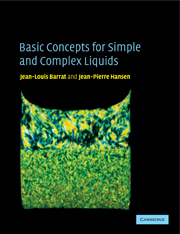2 - A reminder of thermodynamics
Published online by Cambridge University Press: 06 January 2010
Summary
Thermodynamics is the branch of physical sciences developed in the 19th century to provide a systematic theoretical framework for the characterization of physical and chemical transformations of substances, involving exchange of heat, work and matter. It is an essentially macroscopic and phenomenological theory, which ignores the molecular nature of matter; in fact at the time the laws of thermodynamics were formulated, atomistic theories were far from being universally accepted. The link between macroscopic thermodynamics and the modern microscopic description of matter was provided later by statistical mechanics, which is the central theoretical tool for the study of complex fluids; this link will be briefly recalled in section 2.2.
A brief summary of macroscopic thermodynamics is provided in section 2.1. This reminder, which emphasizes key concepts based on the two fundamental laws of thermodynamics, more than specific thermodynamic relations, will serve as a constant reference throughout the book. In particular the summary will provide the basis for the phenomenology of phase transitions and interfacial phenomena (section 2.3), as well as for the macroscopic theory of fluctuations in chapter 3, which in turn can be generalized to mesoscopic and microscopic scales (chapter 3, sections 3.4 to 3.5).
State variables and thermodynamic equilibrium
Numerous measurements carried out on a broad variety of gaseous, liquid or solid substances, clearly show that the macroscopic equilibrium states of any substance can be fully characterized by specifying the values of a small number of state variables. In other words all measurable, macroscopic properties of a given substance, say its specific heat, its thermal expansivity or its viscosity, are well defined functions of these state variables.
- Type
- Chapter
- Information
- Basic Concepts for Simple and Complex Liquids , pp. 36 - 68Publisher: Cambridge University PressPrint publication year: 2003



